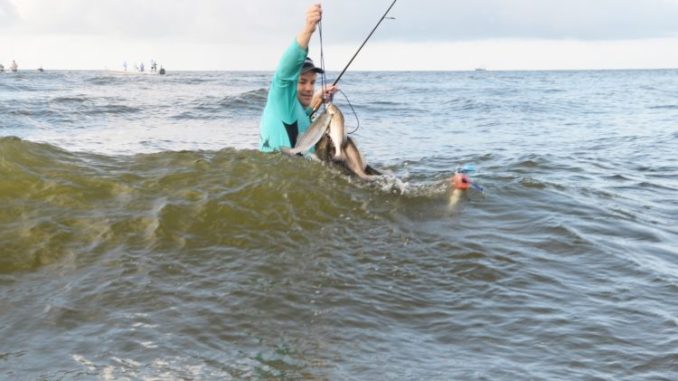
Capt. Theophile Bourgeois said to keep this truth in mind: You’re in Mother Nature’s yard.
Gulf waters hold plenty of sharks, but fishing smart — i.e. don’t cast at passing fins — will generally keep you out of trouble.
“If a shark sees your stringer of fish, he ain’t going away,” Bourgeois said. “So I always pay attention to my surroundings, and I don’t let the stringer get up around my legs.
“I always put my fish to the very back end of the stringer — to the cork — and walk away from my stringer. I’ll take five steps and get the stringer 100 percent away from me.”
Another key point: When you’re unhooking a fish, don’t pin it against your body for leverage.
If a shark rushes the scene, you never want his business end aimed at your profile.
“I tell people to reel the fish within 8 feet of your rod tip, stop reeling, lift your rod tip like a cane pole, get that fish in the net and get him out of the water,” Bourgeois said. “Lift the fish in the net, open the bail on your reel, put your rod under your arm so the reel won’t go under the water and unhook the fish in the net, out of the water.
“String him out of the water and slowly put him in without a bunch of racket.
“Noise and commotion is like a dinner bell for sharks, so I always try to be really quiet with my fish. I don’t want to draw no attention from people I don’t want — meaning sharks.”
To keep waders safe, he offers a few more shark deterrent tips:
• Strategic displacement: “It’s his playground, and if a shark gets too close, I leave,” Bourgeois said. “I cross the beach and go to the other side. If I’m Gulf side (of an island in the Chandeleur chain), I go to the bay side; if I’m on the bay side, I go to the Gulf side.”
• Heel stomp: Most mistakenly think stomping your foot scares away sharks, but Bourgeois said this creates commotion that might actually entice an already aggressive shark.
Instead, you should give off subtle warnings.
“What you do is lift your foot maybe an inch off the bottom and hit with your heel in the sand,” he said. “Just a good stout hit with your heel, and nine times out of 10 that shark will leave.
“Especially, little sand sharks: They feel that thump and they’re gone.”
• String trout right: Probably the most common mistake waders make is improperly stringing their catch. Running the cord in the mouth and out the gills will kill trout, and all dead things quickly release body fluids thick with shark-temping scent.
“You want to string your fish through the bottom lip and the top lip so he can close his mouth and breathe normally by running water through his gills,” Bourgeois said. “You do that and your fish will live all day long.
“As soon as you kill them, that’s when the sharks come in because they pick up on the smell of death. If you have a bunch of dead fish on your stringer, you’re not getting rid of the sharks; you gotta move because they know that’s dinner.”
Noting that the live-stringer method works for redfish and flounder, as well as trout, Bourgeois said he’s seen sharks swim right past him and his live fish and never show any interest.
“If you have a dead fish on your stringer,” he said, “that shark will start zigzagging until he pinpoints it.”


